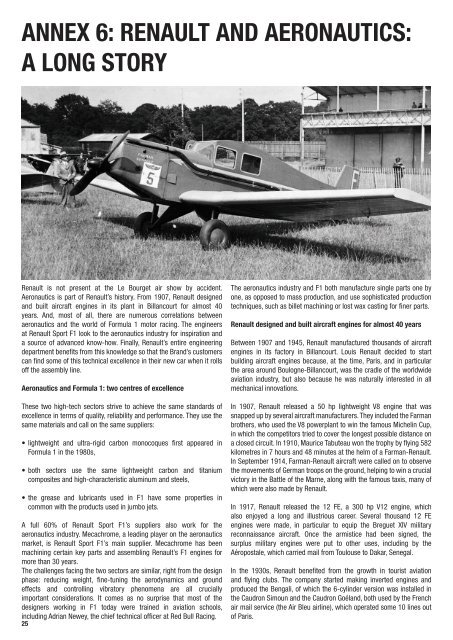THE ENERGY F1-2014 - Renault Sport
THE ENERGY F1-2014 - Renault Sport
THE ENERGY F1-2014 - Renault Sport
You also want an ePaper? Increase the reach of your titles
YUMPU automatically turns print PDFs into web optimized ePapers that Google loves.
ANNEX 6: RENAULT AND AERONAUTICS:<br />
A LONG STORY<br />
<strong>Renault</strong> is not present at the Le Bourget air show by accident.<br />
Aeronautics is part of <strong>Renault</strong>’s history. From 1907, <strong>Renault</strong> designed<br />
and built aircraft engines in its plant in Billancourt for almost 40<br />
years. And, most of all, there are numerous correlations between<br />
aeronautics and the world of Formula 1 motor racing. The engineers<br />
at <strong>Renault</strong> <strong>Sport</strong> <strong>F1</strong> look to the aeronautics industry for inspiration and<br />
a source of advanced know-how. Finally, <strong>Renault</strong>’s entire engineering<br />
department benefits from this knowledge so that the Brand’s customers<br />
can find some of this technical excellence in their new car when it rolls<br />
off the assembly line.<br />
Aeronautics and Formula 1: two centres of excellence<br />
These two high-tech sectors strive to achieve the same standards of<br />
excellence in terms of quality, reliability and performance. They use the<br />
same materials and call on the same suppliers:<br />
• lightweight and ultra-rigid carbon monocoques first appeared in<br />
Formula 1 in the 1980s,<br />
• both sectors use the same lightweight carbon and titanium<br />
composites and high-characteristic aluminum and steels,<br />
• the grease and lubricants used in <strong>F1</strong> have some properties in<br />
common with the products used in jumbo jets.<br />
A full 60% of <strong>Renault</strong> <strong>Sport</strong> <strong>F1</strong>’s suppliers also work for the<br />
aeronautics industry. Mecachrome, a leading player on the aeronautics<br />
market, is <strong>Renault</strong> <strong>Sport</strong> <strong>F1</strong>’s main supplier. Mecachrome has been<br />
machining certain key parts and assembling <strong>Renault</strong>’s <strong>F1</strong> engines for<br />
more than 30 years.<br />
The challenges facing the two sectors are similar, right from the design<br />
phase: reducing weight, fine-tuning the aerodynamics and ground<br />
effects and controlling vibratory phenomena are all crucially<br />
important considerations. It comes as no surprise that most of the<br />
designers working in <strong>F1</strong> today were trained in aviation schools,<br />
including Adrian Newey, the chief technical officer at Red Bull Racing.<br />
25<br />
The aeronautics industry and <strong>F1</strong> both manufacture single parts one by<br />
one, as opposed to mass production, and use sophisticated production<br />
techniques, such as billet machining or lost wax casting for finer parts.<br />
<strong>Renault</strong> designed and built aircraft engines for almost 40 years<br />
Between 1907 and 1945, <strong>Renault</strong> manufactured thousands of aircraft<br />
engines in its factory in Billancourt. Louis <strong>Renault</strong> decided to start<br />
building aircraft engines because, at the time, Paris, and in particular<br />
the area around Boulogne-Billancourt, was the cradle of the worldwide<br />
aviation industry, but also because he was naturally interested in all<br />
mechanical innovations.<br />
In 1907, <strong>Renault</strong> released a 50 hp lightweight V8 engine that was<br />
snapped up by several aircraft manufacturers. They included the Farman<br />
brothers, who used the V8 powerplant to win the famous Michelin Cup,<br />
in which the competitors tried to cover the longest possible distance on<br />
a closed circuit. In 1910, Maurice Tabuteau won the trophy by flying 582<br />
kilometres in 7 hours and 48 minutes at the helm of a Farman-<strong>Renault</strong>.<br />
In September 1914, Farman-<strong>Renault</strong> aircraft were called on to observe<br />
the movements of German troops on the ground, helping to win a crucial<br />
victory in the Battle of the Marne, along with the famous taxis, many of<br />
which were also made by <strong>Renault</strong>.<br />
In 1917, <strong>Renault</strong> released the 12 FE, a 300 hp V12 engine, which<br />
also enjoyed a long and illustrious career. Several thousand 12 FE<br />
engines were made, in particular to equip the Breguet XIV military<br />
reconnaissance aircraft. Once the armistice had been signed, the<br />
surplus military engines were put to other uses, including by the<br />
Aéropostale, which carried mail from Toulouse to Dakar, Senegal.<br />
In the 1930s, <strong>Renault</strong> benefited from the growth in tourist aviation<br />
and flying clubs. The company started making inverted engines and<br />
produced the Bengali, of which the 6-cylinder version was installed in<br />
the Caudron Simoun and the Caudron Goéland, both used by the French<br />
air mail service (the Air Bleu airline), which operated some 10 lines out<br />
of Paris.


